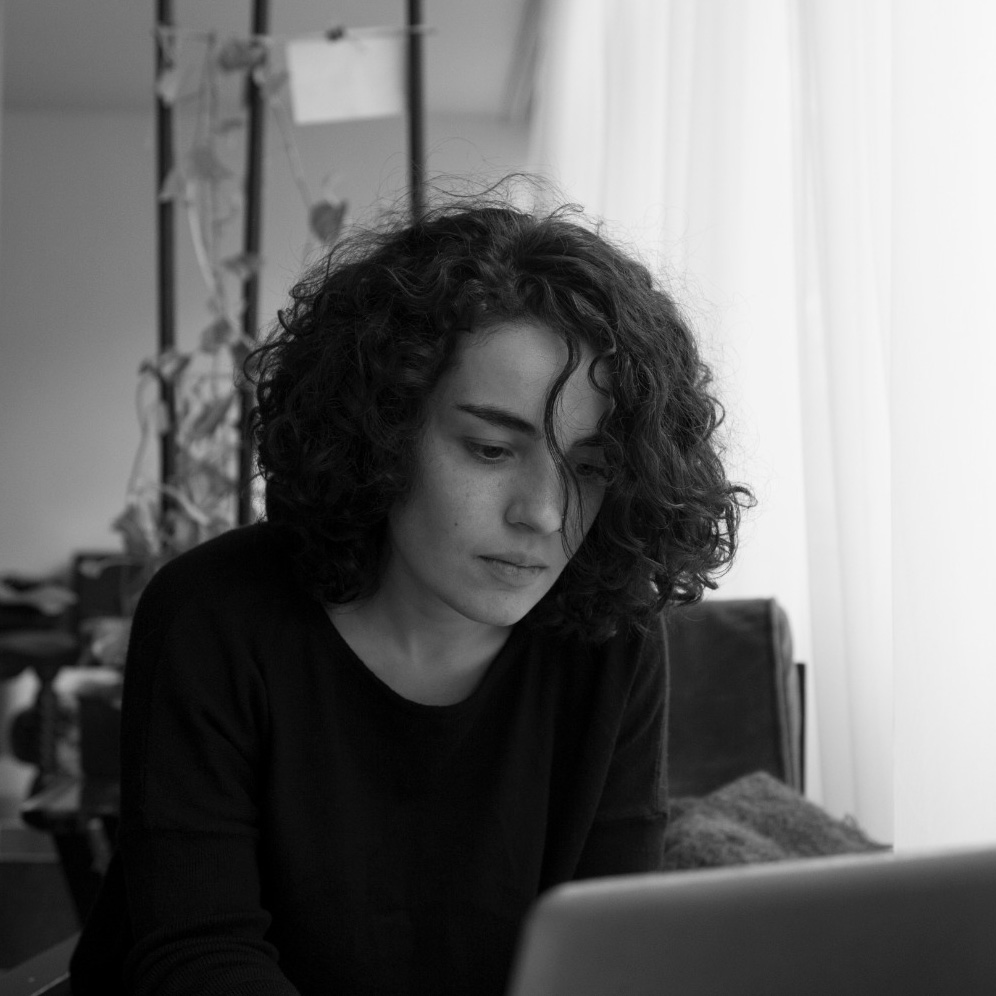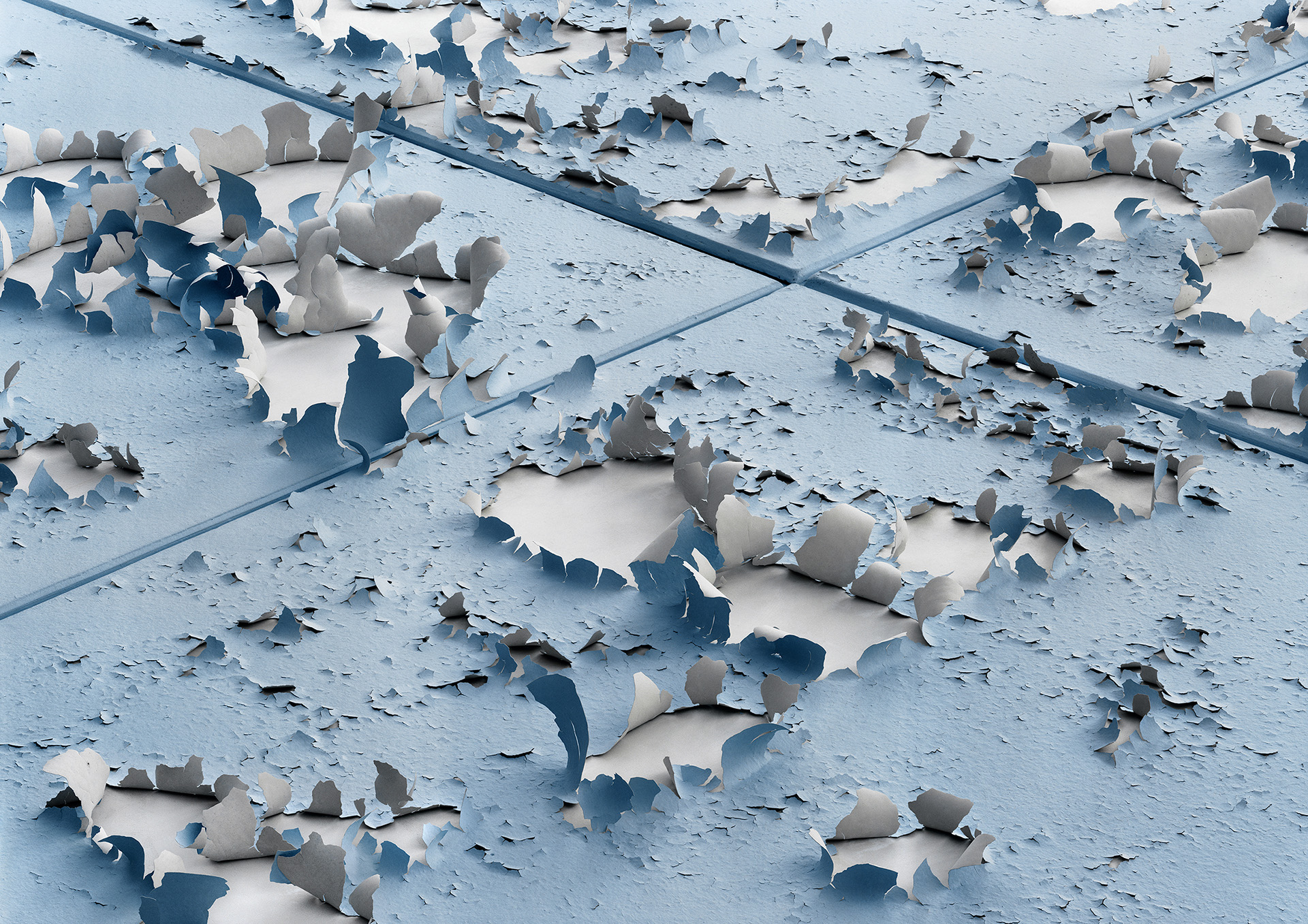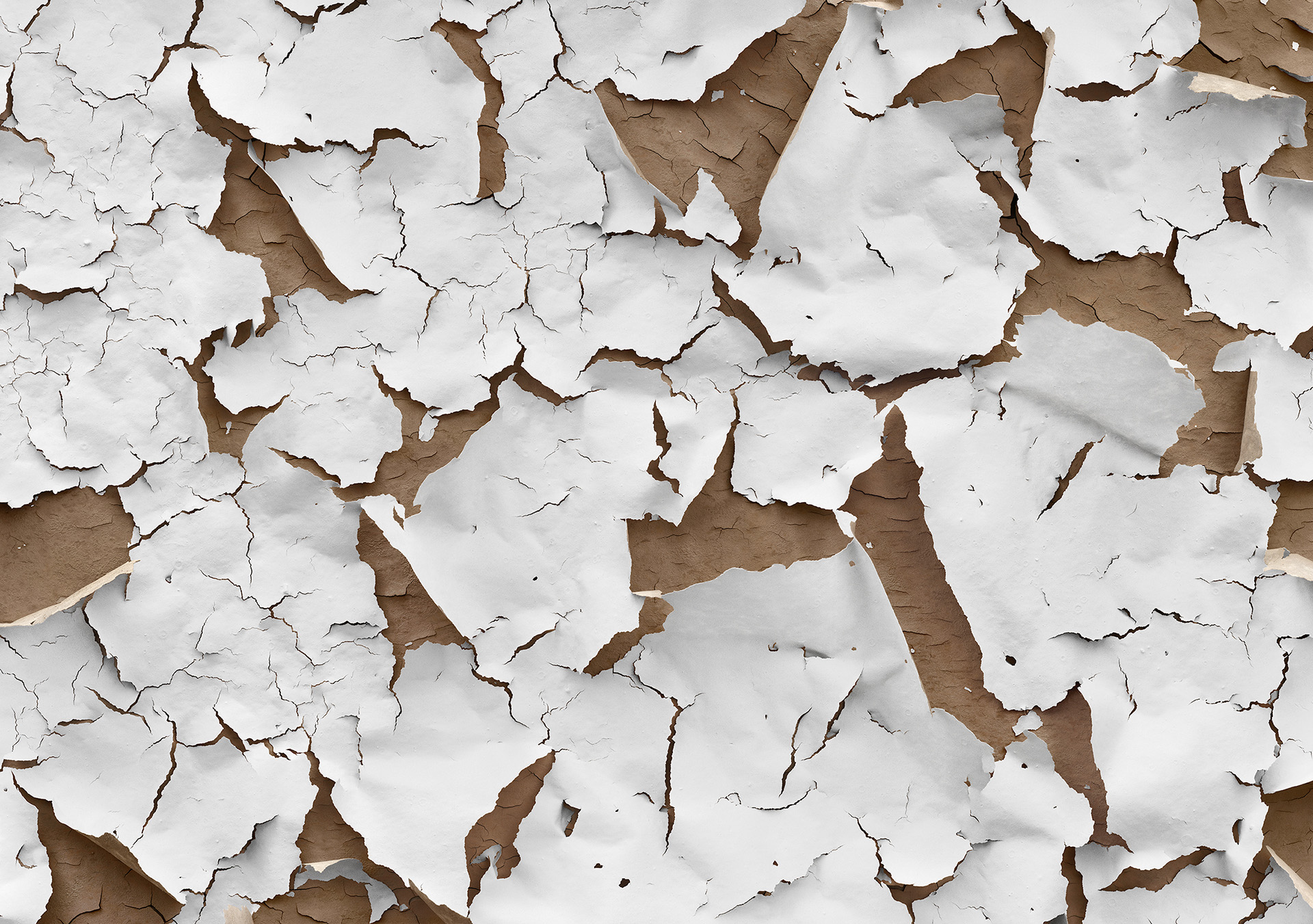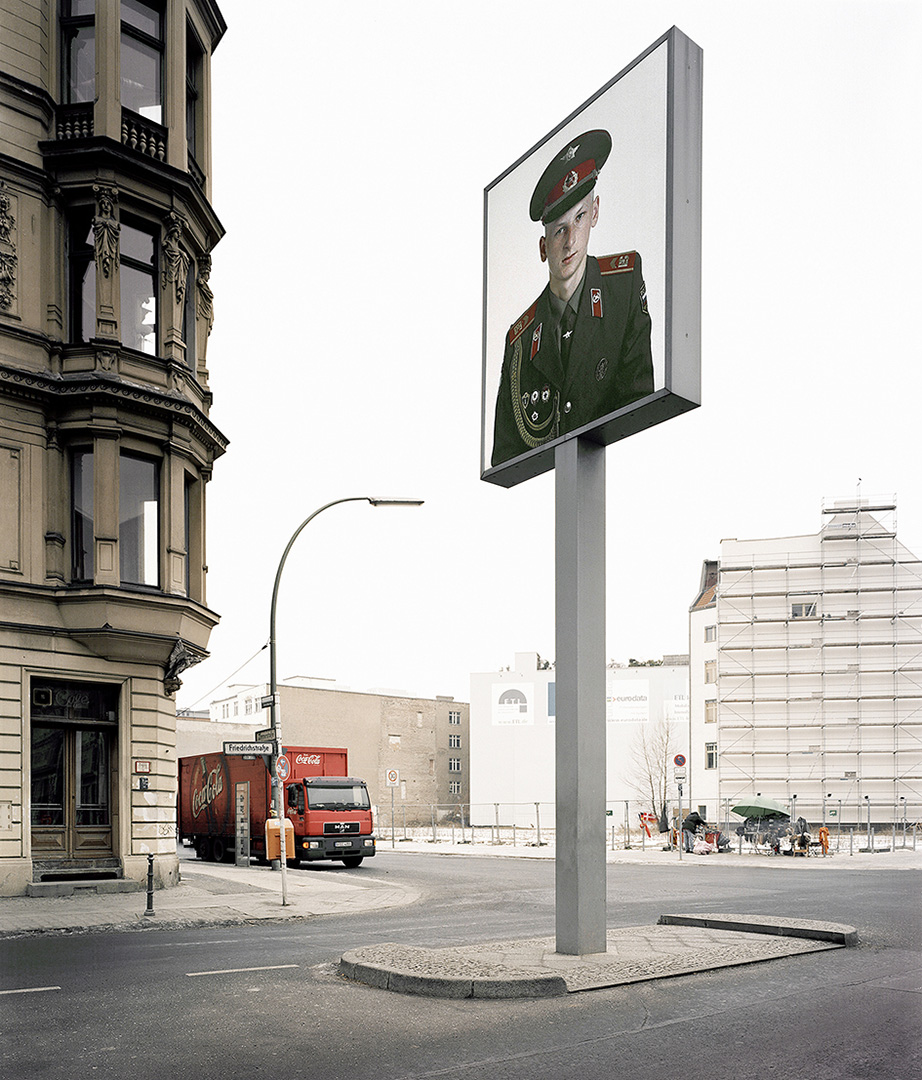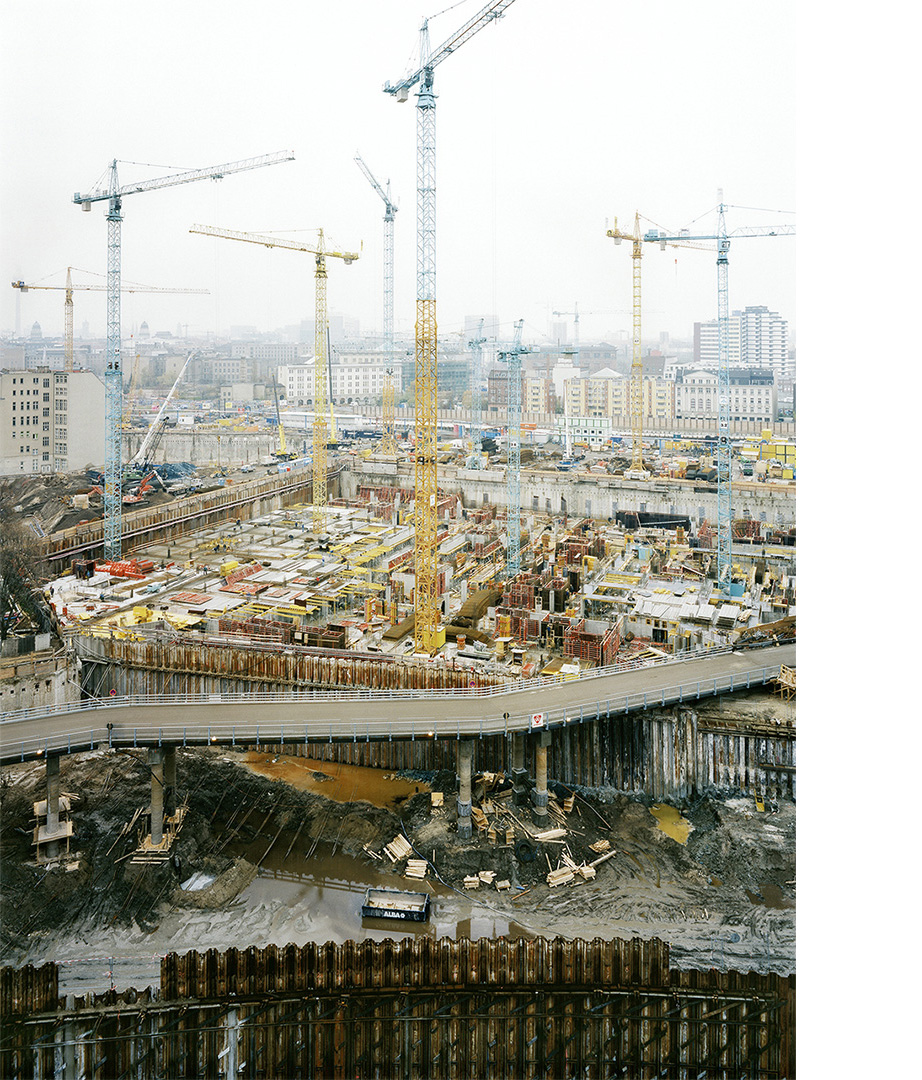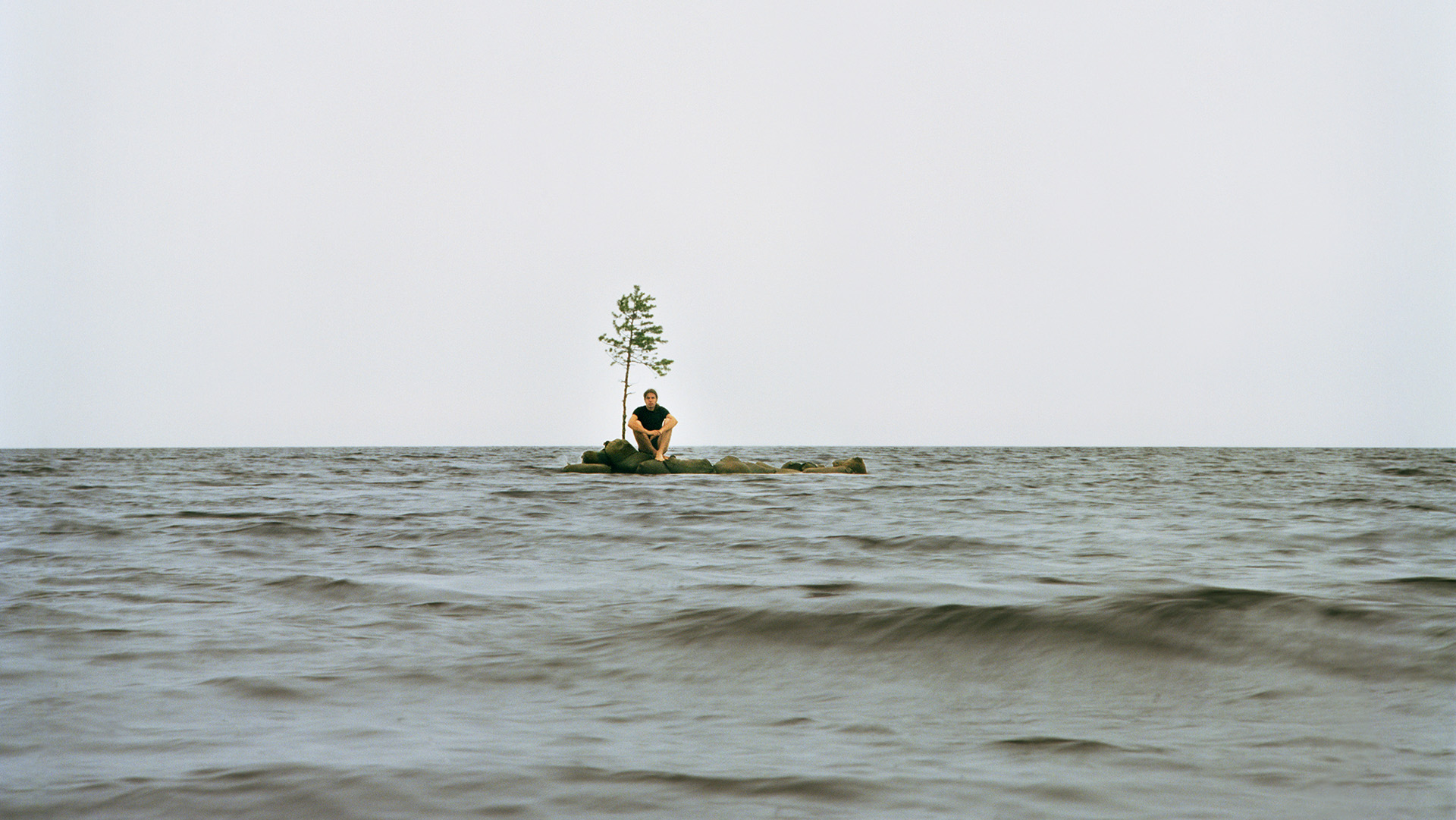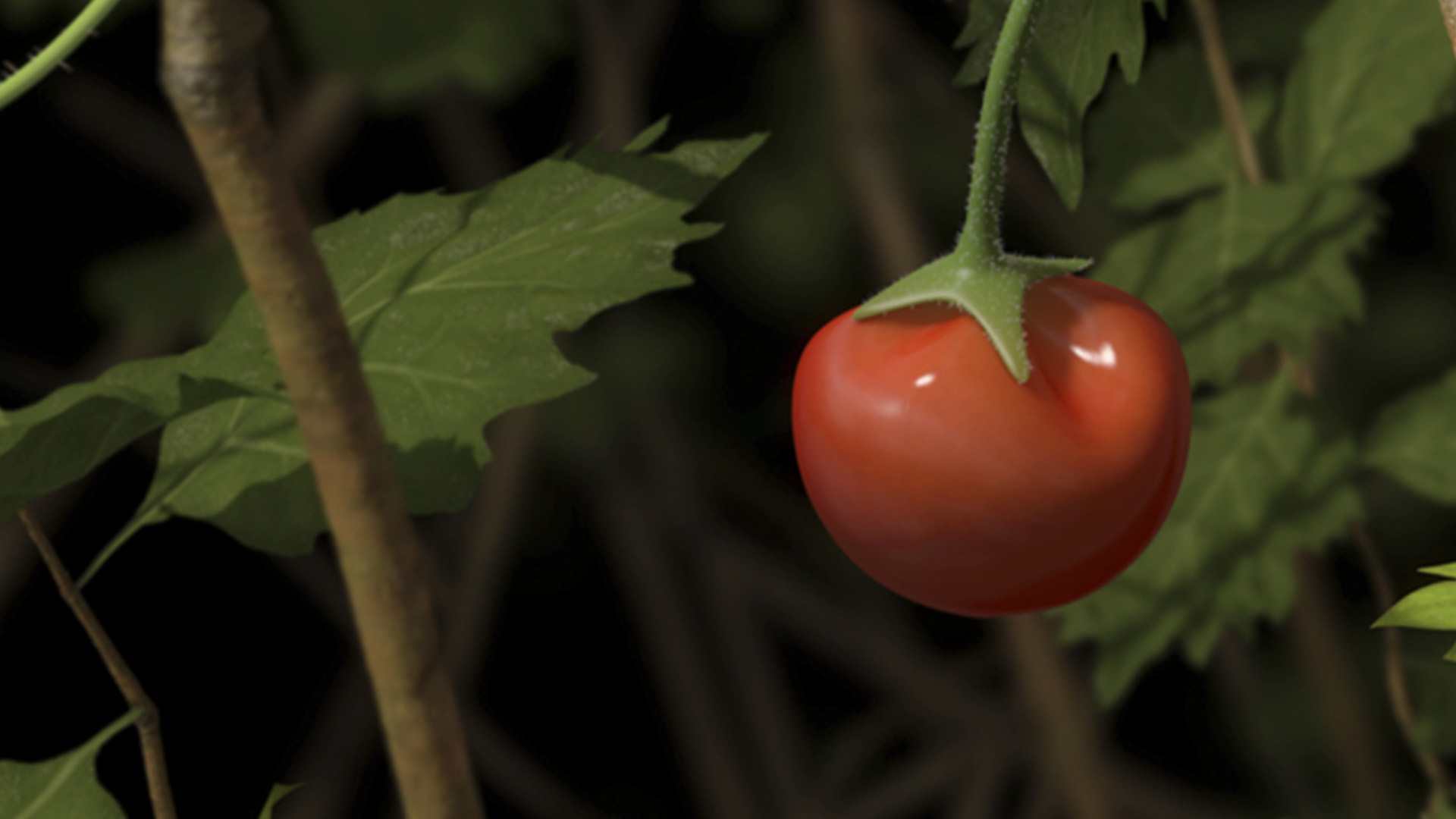Blog
Fully-intended But Non-Explanatory: An Interview with Frank Thiel
16 March 2021 Tue
Frank Thiel is a German photographer who was born in the 1960s, in Kleinmachnow near Berlin, where he moved in the late 1980s to study photography.
I take the risk of commencing with this seemingly dull and cliché opening sentence, for these phrases contain highly significant clues to the production of the artist. Frank Thiel is a photographer, who has witnessed almost the entire period of the Berlin Wall, breathed the atmosphere that complemented it, and assumed photography as a tool of expression at the exact point in time coinciding with the fall of the very wall.
That being the case, when contemplating his works, one should keep in mind the gradually globalizing structure and the transforming features of the city in the post-wall period, its history buried in dust or peeling/stripping off the crumbling facades; hence the former structure of Berlin, which in his words “suffers from an overdose of history”. His photographs, which may otherwise be deemed as minimal, conceptual, or even abstract at first glance, link with one another with this information. As they integrate, delicate stories emerge. He tells that, “These 20 years of work are like a process, almost organic for me, like the branching of a tree. If you put a timeline on the works you could see that almost everything refers to everything, that I go back and forth all the time, that I intensify certain elements and others I don’t follow anymore (at least for a certain time)” in another interview. 1
We can observe that his focus has also shifted away from Berlin (again, at least for a certain time) in his relatively recent works, Perito Moreno or Quinceaneras. The underlying motives for this shift, his position regarding the question of exhibit beyond production, and how he approaches the idea of landscape photography in general are all revealed in his own words.
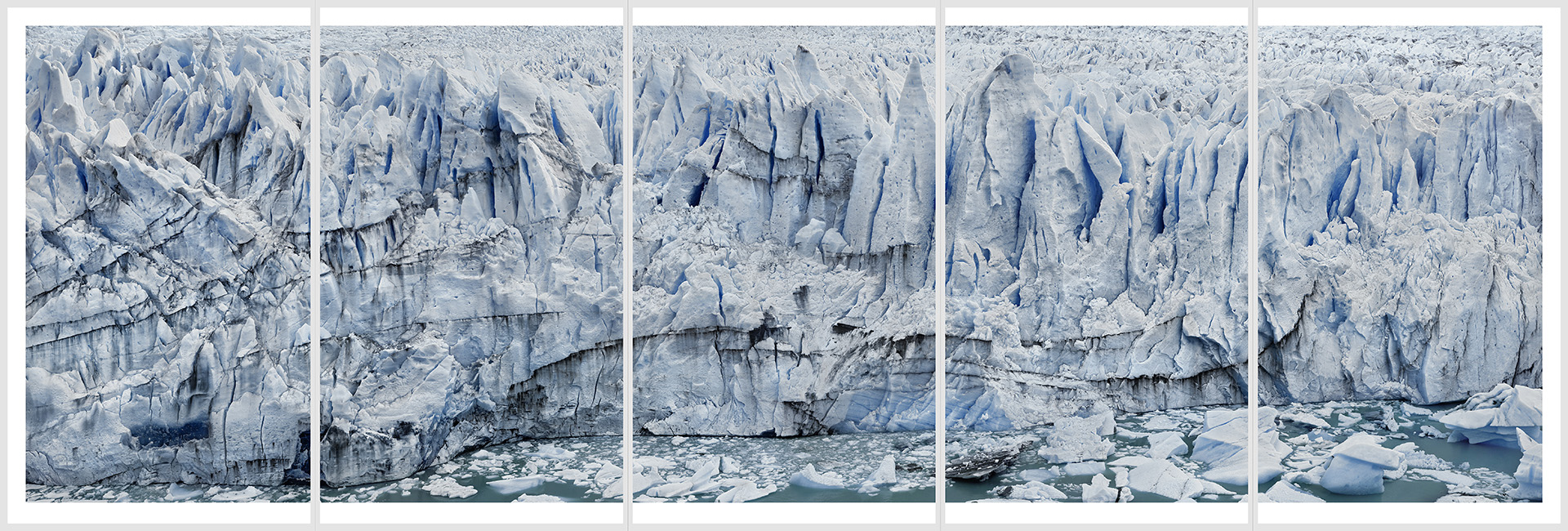
Frank Thiel, Perito Moreno #01, 2012-2013
***
I remembered the first time that I saw your works. I thought they were conceptual works with a motivation for creating an aesthetic and visual form. However, as one digs deeper into them, their fairly subtle symbolic and sociopolitical aspect gleams. What is the essential motivation in your production? Where do you position your photography between the aesthetical and the political?
In my artistic practice, I never start with a visual idea but always from a point of knowledge, of intellectual and emotional involvement with the subject matter. Before taking any picture I spend a lot of time making myself knowledgeable and studying the subject matter that I intend to work about. But this is not at all a sort of underestimation or disregard of the visual part of my work. This is just my way of, so to say, making the soil fertile before I start thinking about the visualisation of my ideas with the same care and intensity.
This deep feeling of the temporary nature, the volatility of almost everything that surrounds us is what draws me almost automatically to places that are unfinished, intermediate and that have an uncertain future. Over the years I developed a deep interest in places and socio-cultural constellations that undergo a profound transformation, transition and I do very much favour the processual and the interim status over the end results.
It’s just natural that these convictions are then inscribed in my works and in this regard, the conceptual nature of my works might often overwrite their implied visual strategies.
I wouldn’t call this per se political since this practice is rather rooted in an intellectual, psychological, and emotional space.
Your works have focused on documenting the architectural and sociopolitical landscape of Berlin for over 20 years. During this time, they have shown the changing face of Berlin after the GDR regime. Here, pieces such as curtains, peelings, and Berlin constructions express themselves in a visually minimal viewpoint. When they come together, they create a sort of constellation. Each piece is unique, and they enrich one another. How did this process make progress; did you plan this from the outset?
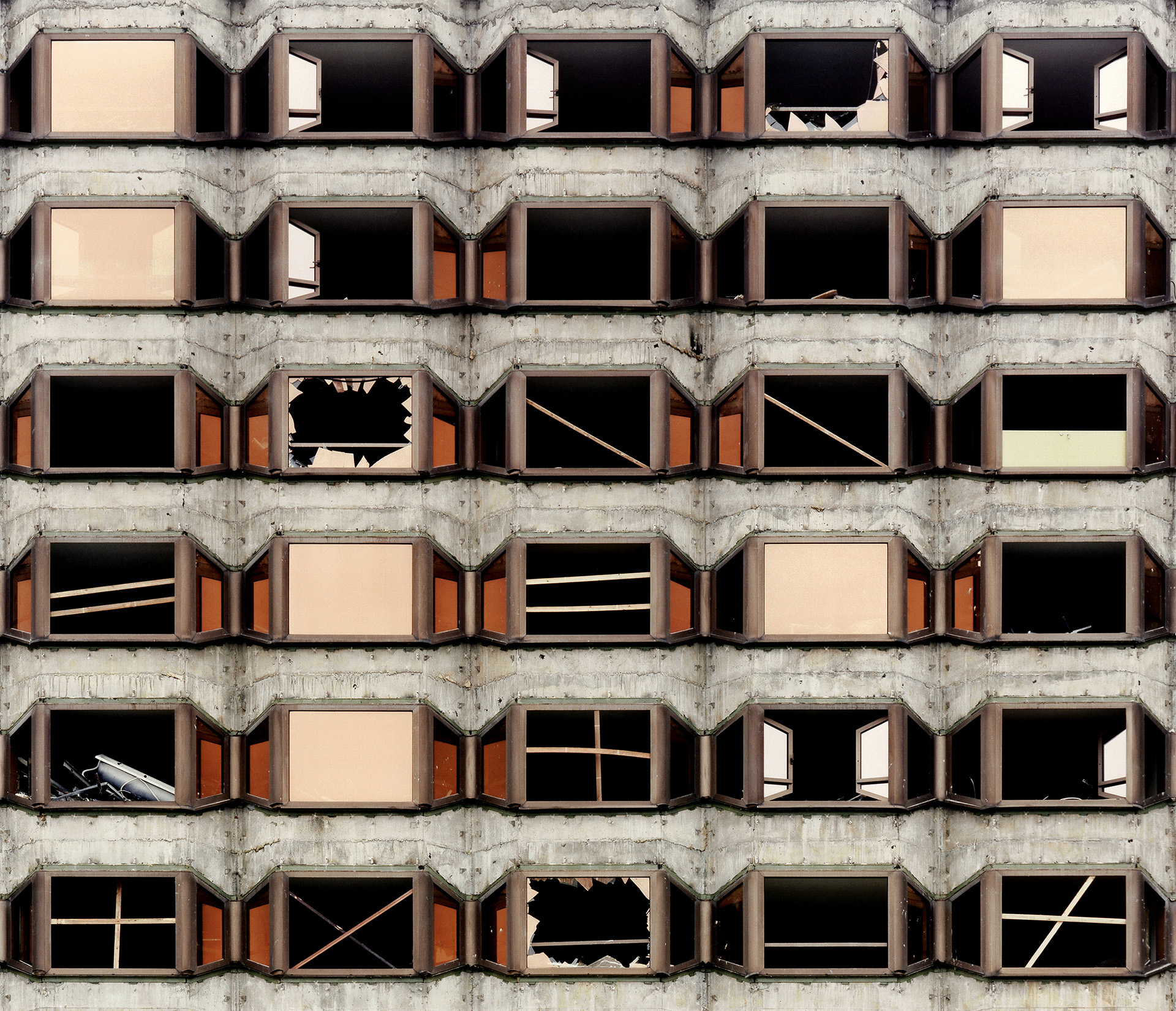
Frank Thiel, Stadt 5/24/A, 2001.
© VG Bild-Kunst, Bonn, courtesy Sean Kelly Gallery, New York, Krinzinger Gallery, Vienna, Leme Gallery, São Paulo.
When I started my work on various aspects of the urban transformation of the post-wall Berlin and the political reverberations connected with it, I had no idea that this larger subject would occupy me for the next 20+ years.
Because I wanted to understand the processes behind urban planning decisions and how they do later manifest in architectural forms I started an intense and long lasting research process first. Additionally I researched how cities have been portrayed historically. This acquisition of historical, theoretical and practical knowledge took almost two years before I felt able to eventually contribute something relevant to the debates about the future of Berlin and to counter the extreme flood of Berlin images with a different form of narration.
Change and transformation are natural and essential for urban environments. But already in the early 90s it was my deep conviction that Berlin would show us in an exemplary way whether we still had the ability at all to build something that can become a city we like to live in or visit at the end of the 20th century. I wanted to address nothing less than this with my work.
The entire city landscape of Berlin is a single urbanistic-spiritual patchwork of the 19th and 20th centuries. But unlike other large European cities with their highly dense central areas that are suffering from the sediments of an overdose of centuries of history, Berlin has been an exception with its empty center as the consequence of numerous outbursts and catastrophes of its history and had therefore a unique chance for a visionary re-thinking of the city as a whole. Now 30 years later one realizes that Berlin has been thought in fragments only in the end. Which I think is very much the result of bad governance, and furthermore a sign of the lack of cultural capability and re-inventive vigor of Western societies.
This was the starting point for this work. The single photographs should appear like snapshots, but at the same time always point to a larger narrative context, i.e. images in which the dialectical relationship between ideology and aesthetics is inscribed.
I decided to concentrate on the processual, the unfinished, the becoming, the transient and to describe within the framework of this aesthetic concept the formation of a new political space within Berlin's urban structures.
The process of working on this series was very similar to the processual character of the theme itself and perhaps therefore the appropriate form of working about it. This series wasn’t created in a chronological way. The work on this series was rather a permanent back and forth, characterized by permanent examination, questioning and challenging of already found visual solutions and artistic achievements, a permanent process of learning and trying.
When you work such a long time about one large subject, which is changing constantly, you have to reflect and eventually implement these changes in your work. It seemed obsolete to me to photograph the city in the very same way over a period of 20+ years because it is not the same city any longer. That’s why this series contains a large variety of formally very different looking works. But in the end, all these works contribute to a much larger overall narrative and do rather form a tree or mycelium than a continuous or chronological line.
It seems that with the Perito Moreno, your focus on Berlin came to an end, and you shifted from “different historical periods of a landscape” to another subgenre of landscape photography, namely nature itself. What was the idea behind this shift and the Perito Moreno?
If someone who is not familiar with my artistic practice does look at all the works I’ve done during the past 30 years, this person might think these works have been created by different artists. Because at first glance the works might seem quite incoherent.
But for me this feels like the most natural thing because my interests, my knowledge, my skills and abilities or more generally speaking my view on and my position in this world is changing as much as the world around us does change.
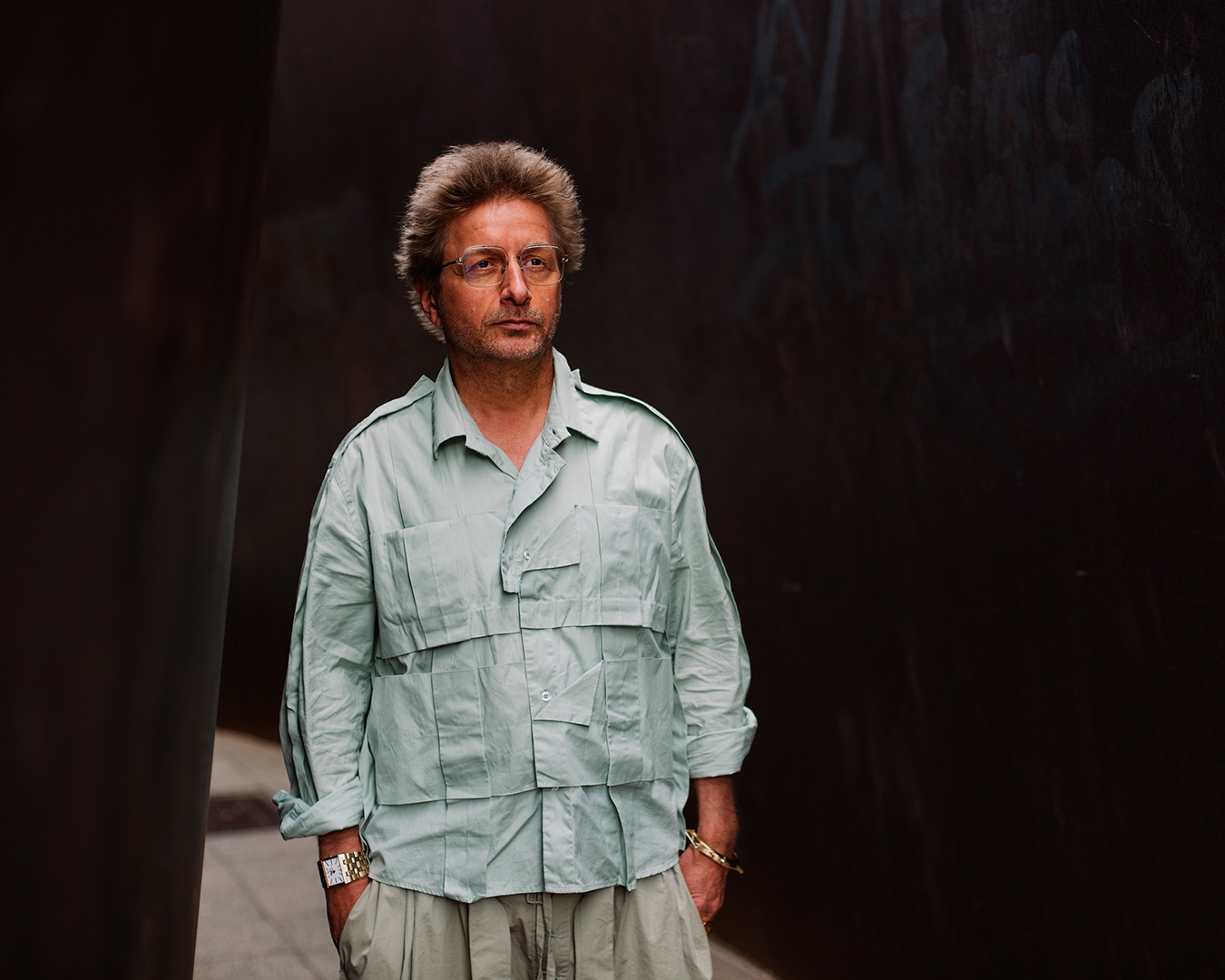
Frank Thiel
© Antony Sojka
Furthermore I was never interested in developing a specific visual language, style or concept that would provide me with a certain framework within which I find my visual solutions. That seemed to me like a self-imposed restriction, like a creative standstill. Some artists might be satisfied with photographing the whole world in a similar way all their life. But I believe that one can and should approach different subjects differently, with an open-minded view, with a curiosity to break new visual ground and with the ability to constantly question your own work and achievements. I am interested in artistic development and I don’t want to feel that my work is jumping on the same spot like a needle on a broken vinyl, even when the music on this vinyl may have found many lovers and received wide acclaim. That’s why I prefer my tree to bear many different kinds of fruits instead of one fruit only.
Keeping this in mind, I would suggest that the glaciers at first glance seem far away or different from my 20+ years lasting engagement with how the urban, political, cultural and social changes in the post-wall Berlin inscribed themselves in the radically changing urban topography of the city. Even though it may look as if the eternity is one of my new subjects with the glaciers, I actually have only spread my aesthetics of the incomplete over to this organic "architecture", these frozen edifices and, executed with a very similar, almost archaeological eye for detail, composition, abstraction and color. Only that these monuments of nature were sculpted and shaped out of ice over thousands of years and thus far are more ancient and gradual than any human construction. The glacial subject enabled me to continuously engage with themes of temporality, ephemerality and transformation, yet spread over the plodding pace of prehistory.
In your works, an essential motivation for you is getting knowledgeable about a specific subject notwithstanding the fact that every encounter between an artwork and an audience is unique, and every person has their own journey with an art piece. I know that you make a lot of preliminary investigations on your subject. But I would like to hear more about the motivations and the preparation part; from the moment you start to think about a subject to the moment an image appears on your screen.
I believe for the viewer there are various ways to engage with an artwork, to read, understand or perceive it. For me there is no such thing like an ultimate interpretation of an artwork and I do encourage the diversity of opinions, views and interpretation.
The reception of an artist’s work is not in the artist’s hand but as an artist you can try to influence the reception of your works, you can leave it either very open or you can try to narrow it down, limit it. Speaking for myself, the content, background, location, story etc. of a work is often very essential for its understanding but I would never see this knowledge as a necessity or requirement to understand an artwork. I’m always trying to leave it as open as necessary and consider artworks rather as a projection screen than as statements carved in stone. My images are more like an invitation or a kind of seduction to follow me somewhere intellectually, emotionally, aesthetically than an answer or a distinct statement.
Your Untitled (1998) installation that stands at Checkpoint Charlie impressed me a lot. It stood at where the Berlin Wall once divided the city between the Soviet and American sectors and consisted of two photographs: One for an American soldier and the other for a Russian soldier. Another example regarding the display of works was your extraordinarily huge glacier picture that makes the audience feel like they are in front of it. In this sense, I would like to ask about the post-photography; in other words, the presentation part. How do you think your works communicate with the audience?
Placing an artwork permanently in the public and placing an artwork in an art space for a limited period of time are very different constellations and therefore do require very different considerations to achieve the potentially desired communication you’re mentioning.
Inside the white cube system the possibilities for dialogue are more foreseeable, predictable and on the basis of these assumptions and the experiences you’re accumulating over the years by exhibiting your works the main decisions are usually done beforehand. When the final works enter these spaces, it is more about adjustments than about the “big” questions.
In my practice I try not to separate the creation and the representation. I believe the earlier aspects of presentation; form and scale are part of the artistic process, the better.
One crucial aspect of photographing glaciers was their physicality, their sheer size. Standing in front of a 60 meters high ice wall and realizing the enormous scale of these glaciers can be a bloodcurdling experience and it fundamentally questions your very own relationship with nature and your place in this world. So I wanted to transfer this very physical sensation into the gallery space by making very large images. But besides celebrating this inescapable, overwhelming, almost magical, imposing and unique beauty, majesty and strength of these glaciers there is all this beauty in their details. All these physical almost impossible shapes and forms and a seemingly endless variation of blues, whites and greys, which I wanted to capture in unknown detailed precision. Such considerations influence or even determine the way you realize the work in the end. For the glaciers, I had to change my complete work process since I couldn’t achieve the desired results with the photographic techniques I had been using before. That’s why the Patagonia images are my first digitally photographed series.
Checkpoint Charlie was a whole different challenge.
The images were taken 4 years prior to winning the artistic competition for the site. So all decisions about the final appearance of the installation could only be made on the basis of the already existing material. The main consideration was to install an artwork that is completely integrated in the existing urban framework of the site and not to add another place of memory to the several others that are already there. The realized lightbox does perfectly serve this idea since it does imitate very common advertising aesthetics and displays that “furnish” our cities nowadays. The two portraits - an American soldier facing East Berlin and a Russian soldier facing West Berlin - almost appear like an oversize traffic sign, but without giving directions. The risky, but fully-intended non-explanatory nature of the installation hopefully applies to the curiosity of the viewers, who ideally ask themselves what they are actually looking at and why exactly here. I see this work as an oversize question mark placed in the middle of the road. The decision for this particular form of memory is also based on the changed urban dynamics of the whole area. What once was a dead-end situation leading to a border checkpoint became a regular crossroad with much accelerated speed of traffic. It would have been a lost opportunity not to reach out to the majority of people who cross Checkpoint Charlie by car, bus, bicycle etc. and create an artwork that can only be perceived by pedestrians.
Obviously, the landscape is no longer just about nature but also the “city”. This aspect becomes particularly apparent in your works. So, what does “landscape photography” mean to you?
Separate genre categories have never played an important role in my creative process. I always intended to try finding the most appropriate artistic form that serves my artistic intentions the best. This resulted in an even larger variety of works, than determined by the process itself, as previously explained in this interview. Many of my works are kind of genre-hybrid or genre-fluid. You find photographs that appear more like drawings, others rather look like abstract paintings; then again other works strongly reference sculpture before anything else, or there are photographs that look like documents but are completely staged.
This might cause some confusion when you look at my work in its entirety. But I do find this wide range and the often implied hybridity very liberating from genre limitations and a more accurate way to describe the very diverse and complex world we are living in.
ABOUT THE WRITER
İpek Çınar
Born in 1992 in Ankara, İpek Çınar has completed her studies in Political Sciences at METU in 2018 and began her graduate studies in the ‘Art in Context’ MA programme at UdK Berlin in 2020.
Working predominantly with the photographic medium since 2011, Çınar tells stories that seek to convey an idiosyncratic language by blending photography with writing. In addition to her photographic production, she contributes to various publications with essays, interviews and series of articles; prepares exhibition catalogues and acts as a content advisor, particularly on photography.
Çınar was among the coordinators of The Booklab project by Frederic Lezmi and Okay Karadayılar; she worked as an instructor for the Darkroom and editing workshops at Ka Fotoğraf Geliştirme Atölyesi (Photography Enhancement Atelier) in Ankara and acted as a content advisor for the photography documentary of TRT 2, İzler Suretler (Faces Traces).
She opened solo exhibitions at Poligon “The Shooting Gallery” and at Ka Fotoğraf Geliştirme Atölyesi and took part in numerous group shows in Turkey and abroad. She has been invited to international artist residencies, workshops and festivals where she participated in exhibition and lecture programs. İpek Çınar, who is also a member of AICA Turkey, is the co-editor of Orta Format Magazine since 2015 and she loves the magazine very much.
